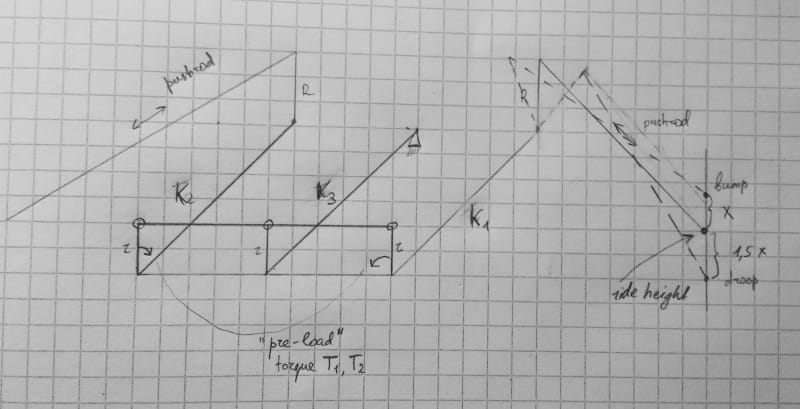GordonPask
Automotive
Hello,
I am looking for an advice on how to would the following system of a series of torsion bars would behave in terms of effective stiffness in various modes: single wheel hop, roll and double wheel-hop.
The system is as follows:
There are three torsion bars K1, K2, K3 of the same length L positioned parallel to each other at equal distances, imagine there are two bearing close to both ends of each of them that allow only rotation, so bars don't slide or turn and remain parallel.
At one end of all three bars there would be a rocker of short arm length r pointing upwards in our "ride height" position. So all three small rockers are parallel.
The other ends of these rockers are connected between each other by a long bar with three holes, so if we turn one of the torsion bars, the remaining two will turn by the same degree.
Now on the other end of the bars the situation is as follows: The middle bar is connected at that end to chassis, while the "corner" bars have rockers of bigger arm R that connect pushrods to input wheel movement into your system.
Now to have droop springing, we would have applied initial torque t1 and t2 (at ride height) to the "corner" bars (for example it could be achieved by having the adjustable lengths between holes on the bar that connects small rockers).
How would such system behave when we apply single wheel bump adding the torque R*f1 to the end of the corner bar?
What would happen in double hop (such as heave or pitch)?
In roll?
Thank you
Gordon
I am looking for an advice on how to would the following system of a series of torsion bars would behave in terms of effective stiffness in various modes: single wheel hop, roll and double wheel-hop.
The system is as follows:
There are three torsion bars K1, K2, K3 of the same length L positioned parallel to each other at equal distances, imagine there are two bearing close to both ends of each of them that allow only rotation, so bars don't slide or turn and remain parallel.
At one end of all three bars there would be a rocker of short arm length r pointing upwards in our "ride height" position. So all three small rockers are parallel.
The other ends of these rockers are connected between each other by a long bar with three holes, so if we turn one of the torsion bars, the remaining two will turn by the same degree.
Now on the other end of the bars the situation is as follows: The middle bar is connected at that end to chassis, while the "corner" bars have rockers of bigger arm R that connect pushrods to input wheel movement into your system.
Now to have droop springing, we would have applied initial torque t1 and t2 (at ride height) to the "corner" bars (for example it could be achieved by having the adjustable lengths between holes on the bar that connects small rockers).
How would such system behave when we apply single wheel bump adding the torque R*f1 to the end of the corner bar?
What would happen in double hop (such as heave or pitch)?
In roll?
Thank you
Gordon

